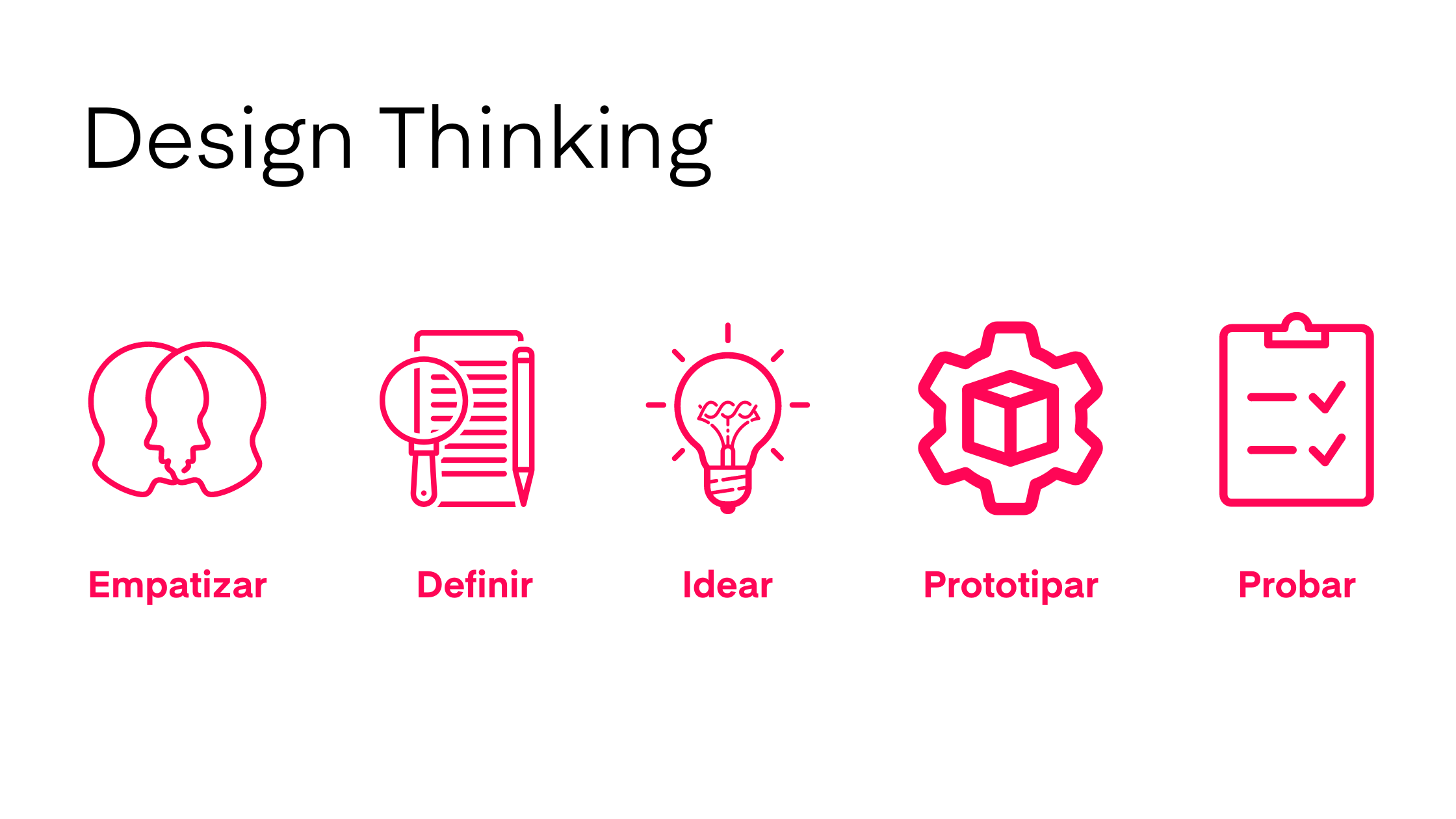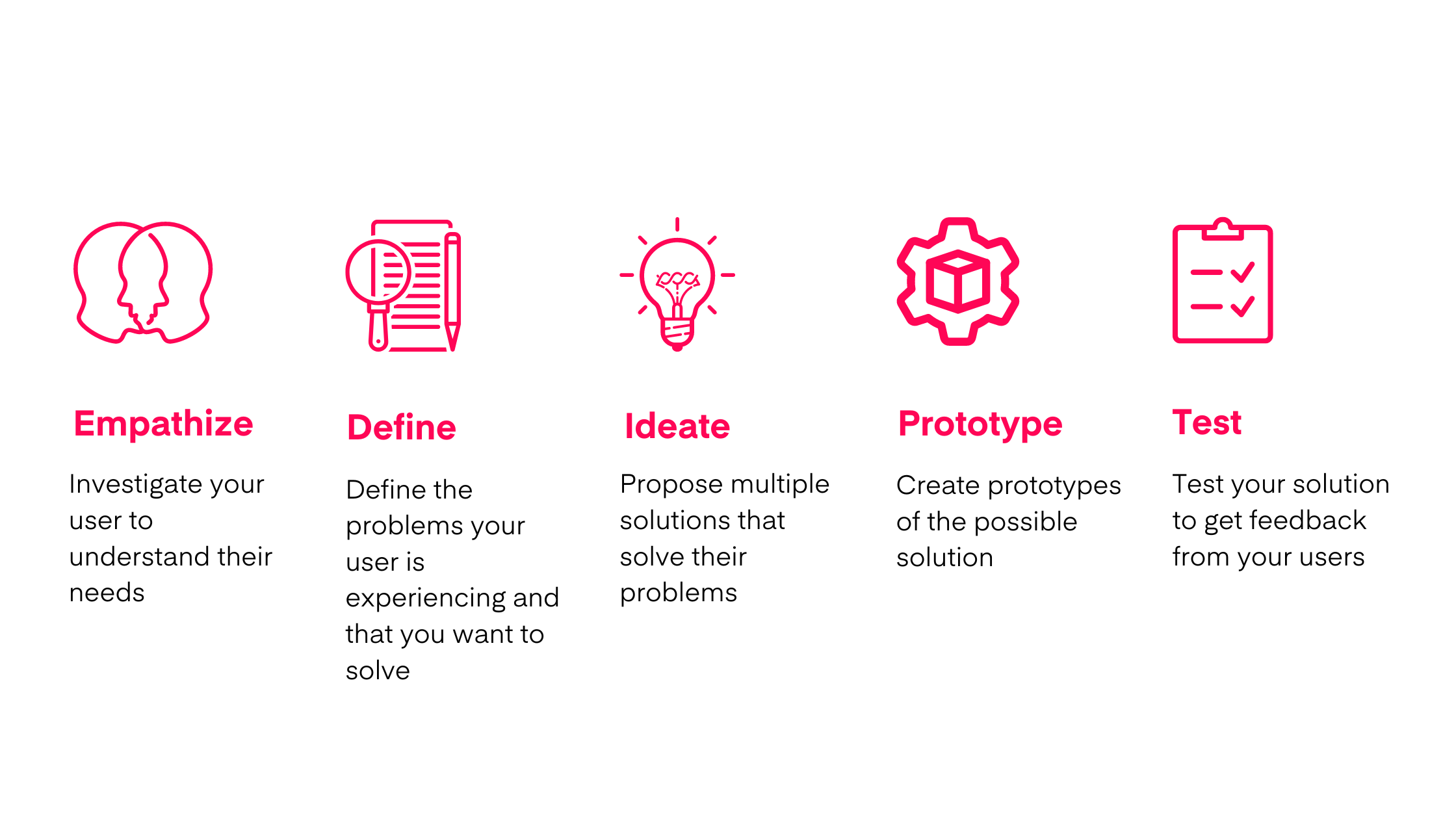What is Design Thinking? Stages and How to Create it

Companies like Apple made a strong debut in the world of technology not only because the design of their products was visually appealing, but also because they made it easier to use computers that previously were only understood by software engineers, allowing for the mass commercialization of these devices and their expansion throughout the world.
The Apple team understood that their brand was not just about selling a product, but about helping their users to use it intuitively. And over the years, they continued to offer new products that addressed new needs that arose as society entered the digital world (such as iPhones, iPods, tablets, smart TVs, and Apple Watches, to name a few).
Created in the 1970s, Apple has remained relevant five decades later because it continues to offer innovative products that solve new problems that arise in the digital world.
How has Apple continued to reinvent itself and surprise people?
The key behind this methodology of work has a first and last name: Design Thinking. Like Apple, global companies like Google and Airbnb have used Design Thinking as a driving force that improves the world of business. In this article, we will help you understand what it is, why it is important, and how this innovative design process works.
What is Design Thinking?
Design Thinking is a methodology for creating innovative solutions to the needs of our users. It is based on user research, prototyping, and usability testing to find new ways to meet user needs.
It consists of 5 stages: Empathize, Define, Ideate, Prototype, and Test.
Through these stages, the team can gather hard-to-access information and apply a collection of practical methods to help find innovative answers.
Of all design processes, Design Thinking is probably the best for "thinking outside the box".
The 5 Stages of Design Thinking

1. Empathize: Investigate user needs
In this stage, you must have an empathetic understanding of the problem you are trying to solve, usually through user research using techniques such as observation, surveys, and user interviews.
For example, in the year 2000, USBs were created because a team felt it was problematic that computer users were accumulating a large number of 3-inch floppy disks that filled up with just a few files and easily became damaged.
Empathy is crucial for a human-centered design process because it allows you to set aside your own assumptions about the world and gain a real understanding of users and their needs.
2. Define: State user needs and problems
It's time to compile the information gathered during the Empathize stage. Analyze your observations and synthesize that data to define in a few words what those central problems are that you and your team have identified.
By defining the problems, you can establish one or several goals. In the previous case of floppy disks, the definition of the problem would be the low storage capacity of these devices and the fragility of their material that allows them to easily become damaged.
3. Ideate: Challenge assumptions and create ideas
Now, you're ready to generate ideas. The solid knowledge base of the first two stages means that you can start "thinking outside the box," looking for alternative ways to see the problem and identifying innovative solutions to the problem statement you created. Brainstorming is particularly useful here.
For example, in 2012, the Snapchat team came up with the idea that instead of giving its users the option to delete content manually, that content could be automatically deleted after 24 hours.
They found that many users sought privacy and didn't want content posted on their profile indefinitely. And they thought outside the box to create a solution that no one had thought of before and that all social media platforms have since replicated with their own version of auto-deleting Stories.
4. Prototype: Start creating solutions
This is an experimental phase. The goal is to identify the best possible solution for each problem found.
Your team should produce some inexpensive, reduced versions of the product (or specific features found within the product) to investigate the ideas they've generated. This could involve simply creating prototypes on paper, or creating visual or animated prototypes to represent the solution you believe to be most efficient.
5. Test: Test your solutions
Testers who evaluate prototypes rigorously test these tools using usability testing, where real representative users attempt to complete typical tasks while evaluators watch, listen, and take notes.
The goal is to identify any usability problems and correct them.
Although this is the final phase, Design Thinking is iterative: teams often use the results to redefine one or more additional problems. Therefore, you can return to previous stages for more iterations, alterations, and refinements, to find or discard alternative solutions.
In general, you should understand that these stages are different modes that contribute to the overall design project, rather than sequential steps. The goal is to gain the deepest understanding of users and what their ideal solution or product would be.
USBs were, at the time, a small solution to a great need to store, back up, and transfer files between devices that was beginning to emerge with the arrival of computers in our homes and schools.
Why is Design Thinking so important?
Design Thinking may seem like a current concept because of its implications in the design of User Experience (UX) on websites and mobile applications, but Design Thinking has been around since before computers and the internet existed.
It has been of utmost importance in addressing human needs that have arisen over the years, such as the need to create a faster and more efficient train model in the 1960s due to the mass migration of rural populations to cities, or to come up with a seat belt and airbag in cars in the 1970s as an alternative to reduce the percentage of deaths from traffic accidents.
Nobel Prize winner Herbert A. Simon first mentioned Design Thinking in his 1969 book, "The Sciences of the Artificial," and went on to contribute many ideas to its principles. Since then, various organizations from a wide range of industries have considered Design Thinking to be a valuable means of solving problems for users of their products and services.
What do I need to create it?
To begin using the Design Thinking methodology in your company, it's very important to prepare these four points:
1. The Materials
The "materials" used in Design Thinking techniques are within everyone's reach. You can use markers, paper, sticky notes, colored pencils, glue, and a camera.
These will be your tools to promote visual communication, which is fundamental in the method. A picture is worth a thousand words and helps you shape your idea.
2. The Team
In Design Thinking, working in a team is essential. The more diverse it is, the better. This way, you can add different points of view, knowledge, and experience. It is essential to have at least one person with knowledge of the methodology who can guide the process.
Although there should be a stable core of people who participate until the end, others can be added depending on the phase we are in. For example, in idea generation or prototype testing.
3. The Space
Look for a space large enough to work around a table, with free walls to post the information you generate. Think of a bright and inspiring place where everyone feels comfortable and in a good mood.
Have you heard of Google's famous offices? A comfortable and inspiring space invites the muses of inspiration to visit you and, consequently, increases productivity.
4. The Attitude
In the Design Thinking method, attitude is essential. We must adopt what is called the "Designer Attitude." Be curious and observant. In any detail, we can find important information.
We must be empathetic, both with people and their circumstances, and be able to put ourselves in the shoes of others.
Question the Status Quo and not be burdened with prejudices. Be optimistic and positive. Lose the fear of making mistakes and see errors as opportunities. Google's fun offices are possibly the best example of how a workspace can become a fertile ground for new ideas.
Who benefits from Design Thinking?
According to Tim Brown, current CEO of IDEO, Design Thinking "is a discipline that uses the sensitivity and methods of designers to match people's needs with what is technologically feasible and with what a viable business strategy can convert into value for the customer, as well as a great opportunity for the market."
Who uses it?
Although Design Thinking is popular among designers, it is widely used by people in all disciplines. Even among design agencies, the work is famous for being multifunctional: IDEO and similar agencies hire non-designers (chefs, engineers, social scientists, biologists) and integrate them into their project teams to add perspective.
Companies such as Apple, Google, IBM, Nike, or Zara use it. Being a great generator of innovation, it can be applied to any field, from product or service development to process improvement or business model definition. Its application has no limits, and you can let your imagination fly as much as you want.
People from all professions and industries can actively participate as part of Design Thinking teams that develop innovative products and services for every problem that arises in everyday life.
A FUTURE WITHOUT LIMITS
Steve Jobs used to say that people don't always know what they want. If he had asked people what they needed to improve their computer experience in the 2000s, they probably would have asked for "faster" computers instead of imagining smartphones, tablets, and other products that did not exist at the time and that revolutionized the industry.
If Carl Benz had asked people what they wanted to travel faster in the 20th century, they probably would have asked for faster horses instead of imagining a gasoline engine that led to the development of new models of transportation that people never would have imagined as a possibility.
It is the responsibility of the Design Thinking team to think outside the box to offer solutions to problems that users have without giving them "what they ask for or expect" but understanding perfectly the difficulties and frustrations that they experience and helping them with the development of products that make their lives easier.
Thanks to Design Thinking, we can now enjoy innovations such as Voice Assistants (Siri or Alexa), Streaming and Online Course platforms, home taxi service (Uber), Air Fryers, and new inventions that emerge every year to make our lives easier. And undoubtedly, while you are reading this article, there are teams in different parts of the world, in all industries, developing the innovations that will reinvent the present to create a future where imagination has no limits.


